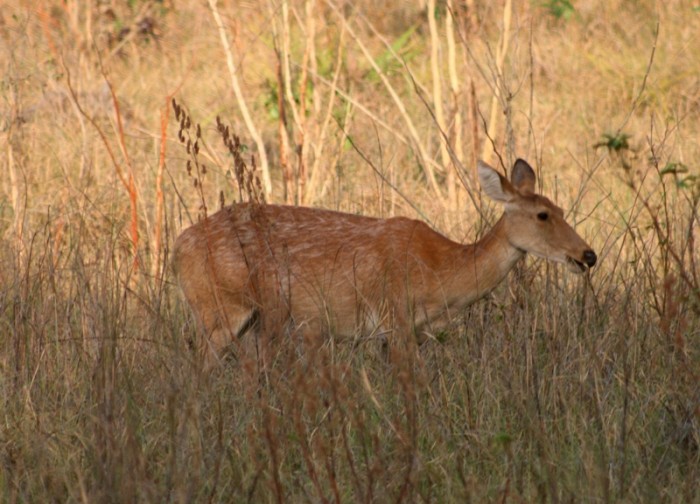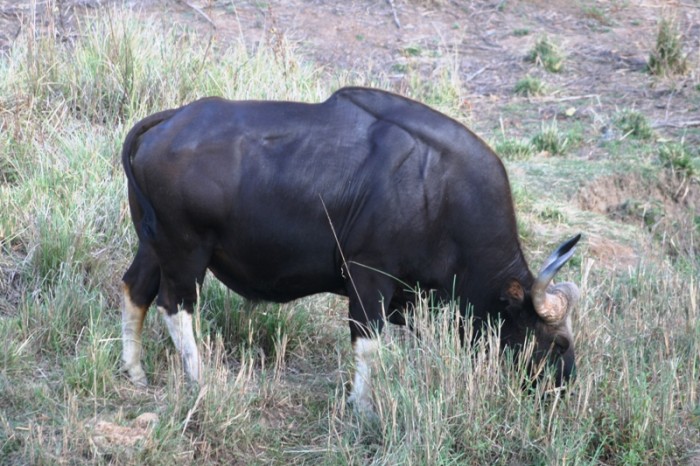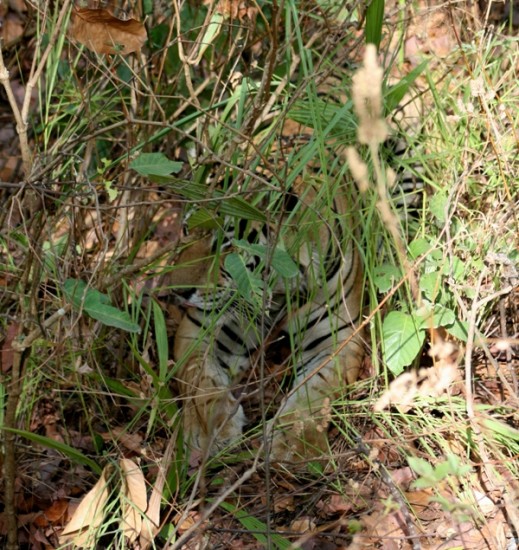As someone who earns his living seeking out birds and snakes in wildlife sanctuaries for foreign tourists in Goa, I’m busiest from November to April. By May my flow of clients is a mere trickle and it’s time to become a tourist myself!
My original plan this year was to travel to Europe. But then I realised I hadn’t yet seen much of the wildlife in my own country, India—although quite a number of people would argue that India is more a continent than a country. And what better way to experience this vast and diverse land than to travel to its best wildlife sanctuaries.
I’m just back from my first excursion which took me to Madya Pradesh, the belly of India. The month of May is when the Indian summer reaches its peak. If you’re looking to escape from the heat, you’d be better off travelling north to the Himalayas, or at the very least, to a hill station like Ooty. But if you’re looking to see tigers there’s no better place than Kanha National park and Bandhavgarh National park, and no better time than at the height of summer.
The dry heat has eaten away at the vegetation and sucked away every last bit of moisture. The only respite for the animals in these wildlife sanctuaries are now a few waterholes still holding out. Hang around these waterholes with a pair of binoculars and you’re almost guaranteed a sighting of the big cats.
Summer in Goa is hot and humid. Summer in central India, I’d been warned, would be hot and dry. Hot and humid sets you up for drowning in your own sweat. On the other hand hot and dry means you’ll dehydrate like a frog sitting in the sun. I’d had enough of Goa’s humid heat, and even though visiting MP at first seemed like going from the frying pan into the fire I imagined that it could be nice for a change at least!
I travelled by train from Goa to Bombay and then Bombay to Jabalpur. Accompaning me was Bindu, a friend of mine from Bangalore, and her daughter Isabel . As I stepped out of our AC coach in Jabalpur I braced myself for searing heat, humans and stray animals dessicated by the sun, the survivors shielding themselves while stealing squinting glances at the sky as they searched for a stray rain cloud.
Imagine my surprise when I stepped into an atmosphere that actually felt cooler than Goa! And the people weren’t dying. In fact, the temperature seemed to be the last thing on their minds! Still, it was seven in the morning when we reached Jabalpur, and all through the bus ride to Kanha, I braced myself for that heat tornado that I was expecting to hit.
But by noon, when we’d finally completed our 160 km long journey, I began to feel quite pleasant and relaxed as I realised that it probably wasn’t going to get much hotter. It was like the relief one must feel when one expects to get killed in a fight but only ends up losing an arm!
‘Can you believe this …it is actually more pleasant than in Goa.’ I kept saying to Bindu. She kept giving me surprised smiles which could only mean that she didn’t quite agree.
The first evening we plonked our bags at Van Vihar right outside Kanha National Park. Lonely Planet lists them as the best budget option. Luckily, I had followed Bindu’s advice and had not made any internet reservation, so we ended up bargaining them down to Rs 300 a day (half of what they were asking!)
Kanha is open to visitors from five to eleven in the morning, and four to six-thirty in the evening. You are only allowed to enter the sanctuary in rented four-wheel-drive Gypsies (a reasonably quiet Maruti petrol vehicle with a body that’s a mix of car and jeep). The park fees are Rs 680/-, including a compulsory guide who is reasonably knowledgeable on most of the fauna around. The Gypsies cost between Rs 800 to 1200 for evening and morning trips, respectively.
The Gypsy rental is money well spent; I imagine the driver uses half the money just for fueling the rigorous three-hour drive through the sanctuary. I did my first trip in the evening sharing the jeep with Bindu and Isabel. The drive was one of the best trips I’ve ever done in any wildlife sanctuary. Photographs cannot capture the sense of vast wilderness I experienced. Kanha has mostly thick wooded Sal forest that opens out suddenly into extensive grasslands.
The grasslands support a huge grazing population. chital (spotted deer) are the most common here and over 20,000 of them thrive here. In fact the animals here are so used to Gypsies driving by that they take little notice even if you are only a couple of meters away.
Besides chital, we saw several gaur, langur, sambar deer, and peafowl. The peacocks were in their element, with many of them displaying, their huge tails fanned out to impress females. Wild boar, barking deer and barasingha (a species of deer found only in Kanha) were a lot less common, though still not difficult to find.
There were also quite a few bird species which mostly stuck close to the waterholes. Some of the more common birds included the Black Rumped Munia, Whitebellied Drongo, Whitebellied Blue Flycatcher, Flamebacked Woodpecker, Rufous Treepie, Alexandrine Parakeet, Plum headed Parakeet,White throated Kingfisher, Jungle Owlet, Spotted Owlet, Collared Scops Owl, Crested Serpent Eagle and even the rare Racket Tailed Drongo. The birds were chirping and flitting about the place and made light work of the dry heat.
Almost at the end of the first evening in the forest, we spotted three Dhole (Indian wild dogs) sitting right on the Gypsy track. The dogs were lazing around and couldn’t be bothered even when the Gypsies inched to within two meters of them.
The next morning Bindu and Isabel decided to take it easy, so I walked to the main gate alone. My plan was to find a Gypsy with only two or three people and share the cost with the occupants if they could share a seat with me. I ended up striking a deal with the first group of people I met and at five in the morning I was on my way into the forest again.
The morning was cool and pleasant. I noticed that Goa with its hot humid climate stays quite warm even during the nights. But the dry air in Kanha makes for easy heat loss, with the result that temperatures dropped the moment the sun went down. No wonder deserts are freezing at night!
Our first interesting sighting was that of the wild dogs again. They had killed a chital and were devouring it. One of them kept chasing the crows that kept creeping closer. Just two hours later, when we returned to the same spot, almost the entire carcass had been picked clean.
A Muscle bound male Gaur (Indian Bison)!

Female Barasingha
Possibly, more than 90 per cent of people who make it to Kanha or Bandhavgarh are there only to see a tiger. All other animals, birds, the immense trees and beauty of the forest is wasted on them. The success of their trip is measured by how many tigers they see. It was no surprise therefore that all the Gypsies were almost exclusively hunting for tigers.
The Gypsy tracks, worn out by tyres and the baking sun, raised clouds of dust. If you were behind another Gypsy there was no escape. Most people were prepared with a scarf or something similar. I had to make do by sticking my nose inside my t-shirt.
There were plenty of fresh tiger pug marks on the soft dusty tracks. It was not just us who used the tracks. Apparently, unless they were hunting, the tigers also preferred the soft dusty tracks to walking in the thorny undergrowth! When the driver of our Gypsy finally managed to locate a tigress with cubs, I missed it.
I was sitting at the front of the Gypsy and by the time I could stand up to look over the high grass she had disappeared. Only one guy behind me caught a glimpse of it, and he was smiling from ear to ear.
I was excited. After all these years I might finally get to see a tiger in the wild. A ladder was placed at the side of my elephant and I climbed onto it. My camera was ready. Sitting on an elephant walking through the jungle is quite an experience. The pachyderm just walks through any thorny shrub or over any large boulder almost as if it didn’t exist. It would put an SUV like the Hummer to shame by literally making its own road!
Still, I had to be careful. The elephant didn’t seem to care about bumping and scraping against tree trunks and I could have easily have broken my leg if I didn’t watch out. In thirty seconds we were upon the tiger. It was a massive male and as our elephant approached closer he growled and backed himself into the undergrowth. The growl seemed playful but it also betrayed the immense power of the big cat.
Well settled in the undergrowth the tiger seemed least bothered by the three elephants standing within a few meters of it. He yawned. Obviously he was resting. I snapped a couple of shots with my camera. I wish I could just stay there and watch him for a while, but the mahouts were making too much noise moving the elephants. They urged them closer to the tiger. They were now too close for comfort. I realized if the tiger had to lose it he could be upon us before anyone could bat an eyelid.
He was now clearly disturbed and got up and started to move deeper into the undergrowth. I presumed the mahout would take us back now. But instead he urged our elephant to follow the tiger. The three elephants were now clearly annoying the big cat. I wouldn’t be surprised if he charged us then. Eventually, he settled into a dense portion of the thicket and our mahout turned the elephant around.
A few days later I would learn that only a week before my close friend Mrinal had fallen off an elephant when an enraged tusker chased them away for getting too close. Mrinal suffered compound fractures in his right tibia. The doctors had to put his leg in a cast for the next two months, and it would be six months on crutches and a year of physiotherapy before he could walk again.
As I climbed down from the elephant I had mixed feelings about my first tiger sighting. Sure, I had felt the immense thrill and the adrenaline rush of being so close to one of the most magnificient and powerful predators on the planet. At the same time I couldn’t help but wish that my sighting had been less obtrusive. I’d have been content to observe the tiger with a pair of binoculars.
There were still a couple of people waiting their turn to catch a glimpse of the tiger and they were chattering loudly. I couldn’t imagine how the tiger could tolerate all the racket and I was sure it would disappear soon.
When I got back, Bindu and Isabel were ready to check out of Van Vihar. For that day we had made an internet booking at the Baghira Lodge located within the National park. Rooms at Baghira are quite expensive (approx four thousand a day) so we had chosen the dormitory option (which cost us 680/- per person including meals). Even though the Baghira lodge is located within the park, I didn’t find any other advantage to it, and I therefore didn’t find it worth the extra money spent. Were it not for my advance booking I would have continued staying at Van Vihar.
In the evening Bindu, Isabel and I managed to share a trip with a family of four and this time we were lucky to see a leopard. It was a big male and so well camouflaged that had it not been for the warning calls of a langur up in the trees we might have not seen it at all. The leopard was on higher ground and clearly apprehensive about us. It seemed like he might cross the Gypsy track in front of us, and after a short wait he finally crossed, stealing a quick glance at us. Another spectacular sighting.
That would be my third and last trip at Kanha. The next morning I caught the first bus back to Jabalpur. I had heard a lot about the tiger sightings at Bandhavgarh and since I had come all the way to Madya Pradesh I just had to make a trip to this National park. Bandhavgarh has the highest density of tigers in India. The Lonely Planet guide mentions that ‘a day spent in this sanctuary almost guarantees you a tiger sighting.’ Bindu had decided to stay back with her daughter, and she made the right decision. Bandhavgarh, as it turned out, was over 350 kilometers away!
Unlike Kanha, there are no direct buses to Bandhavgarh from Jabalpur. So I ended up taking a bus to Katni. From Katni, a train took me to Umaria. And from Umaria, I caught the last bus to Bandhavgarh. The bus was packed to the gills and at times I almost felt like screaming and storming off it.
Infact, if it weren’t for a very helpful Munnu Bhai who runs a place called Gitanjali right outside Bandhavgarh, I wouldn’t have got there at all. Munnu Bhai kept in touch with me the entire journey from Kanha to Bandhavgarh and I’m most grateful for his crystal clear instructions and directions and all the help he gave me during my two-day stay there.< I reached Bandhavgarh after a fifteen hour journey. I had hardly eaten anything the whole day and my water bottles were empty. Munnu quickly fixed me a very decent room and an equally decent meal.The next morning I was up at four, but didn’t manage to find anyone at Bandhavgarh willing to share a Gypsy. I was forced to rent a Gypsy all by myself. In addition, the quota for the Gate 1 (the better track for spotting tigers) had been exhausted. I was forced to take the second gate several kilometers away. That raised the cost and I ended up paying almost two thousand rupees for the morning trip. Bandhavgarh wasn’t as exciting for me as Kanha. There were much fewer chital here and no gaur or wild dogs. And while there were still some interesting birds here, the forest was drier with young sal trees interspersed with bamboo vegetation.I much prefered the Kanha landscapes. That evening I managed to share a Gypsy with a few people going into Gate 1. We were alloted route D, a very hilly area. I spotted my second big cat almost at the end of the trip. This time it was a tigress and she was lying on her side, resting in a very shady patch of forest right beside a small rivulet. Over ten Gypsies crowded around waiting for her to get up. We sat for almost half an hour, watching her. Even with all the chattering and noise from the Gypsies, she slept peacefully. Her twithcing tail was the only part that moved. Eventually, she pulled herself up and sat down. For a moment she stared straight at us. The crowd gasped. In that moment I figured she was looking straight at me. I’m sure the others felt the same way. I also realized that she was only ten meters away and should she decide to charge at us there was little I could do. But she soon began lapping from the rivulet and then tried to move to a different spot. That’s when we realized that she was limping. It was almost six-thirty now and she began calling. Her calls were very low-pitched deep moans.The guides told us she was communicating with her cubs. All of us in the Gypsy were excited with the prospects of seeing the cubs but it was already late and we had to leave. When I think back I realize I that Bandhavgarh had been my first choice and the only reason I went to Kanha first was because I had paid in advance for a booking at Baghira lodge. I’m glad I did that. Otherwise Bindu and Isabel would have stayed at Bandhavgarh and probably not seen Kanha at all. On returning, I called up a couple of my friends who had already visited both these places to tell them about my trip. While some of them liked both places equally, I myself prefer and would recommend Kanha over Bandhavgarh any day.



